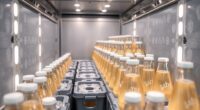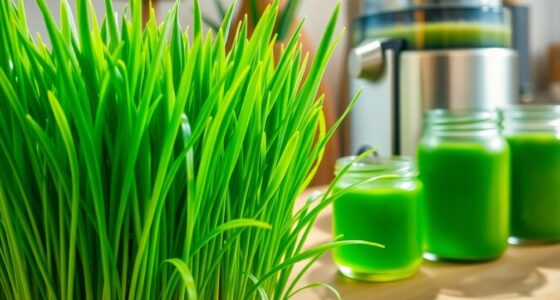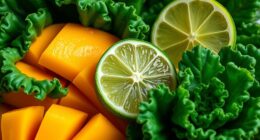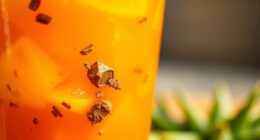Aseptic cartons are multi-layer packages that keep beverages fresh without refrigeration. They use a combination of paperboard for strength, a plastic layer for moisture protection, and a thin aluminum foil to block light and oxygen. This layered design creates a sterile environment, extending shelf life naturally. These cartons also help reduce energy use and greenhouse gases linked to refrigeration. Want to discover how these layers work together and how recycling fits in? Keep exploring to learn more.
Key Takeaways
- Aseptic cartons consist of layers: paperboard for structure, plastic for moisture barrier, and aluminum foil for light and oxygen protection.
- The layers are bonded through advanced manufacturing to create a sealed, sterile environment for long-term product safety.
- Recycling involves separating the layers: paperboard is processed into new paper products, while plastics and aluminum are recovered for reuse.
- The multilayer design maintains product freshness without preservatives or refrigeration, reducing energy use and environmental impact.
- Sustainable practices include recycling efforts and reducing greenhouse gas emissions through minimized cold storage and transportation needs.

Have you ever wondered how your favorite juice or milk stays fresh on store shelves without refrigeration? The answer lies in the clever design of aseptic cartons, a marvel of packaging innovations. These cartons are engineered to keep beverages safe and fresh for extended periods, even in the absence of cold storage. They achieve this through a combination of multiple layers that work together to block out light, oxygen, and bacteria, which are the main culprits behind spoilage. The layered structure isn’t just about preserving the product; it also plays a significant role in reducing environmental impact. By extending shelf life without the need for refrigeration, aseptic cartons help cut down on energy consumption and greenhouse gas emissions associated with cold storage and transportation. This makes them a more sustainable choice compared to traditional packaging options.
The core of an aseptic carton is its multilayer construction. Typically, they consist of a combination of paperboard, a plastic layer, and a thin aluminum foil, each serving a essential purpose. The paperboard provides the carton with strength and structure, making it lightweight and easy to handle. The plastic layer acts as a moisture barrier, preventing leaks and protecting the contents from external humidity. The aluminum foil, often the key to the aseptic process, blocks out light and oxygen, which are critical factors in spoilage. These layers are bonded together through advanced manufacturing processes, creating a sealed environment that keeps the product sterile and safe for long periods. Because of this sophisticated layering, aseptic cartons are highly effective at maintaining product quality without preservatives or refrigeration. Additionally, the layered design allows for customization of barrier properties to suit different types of beverages and storage conditions.
Frequently Asked Questions
How Are Aseptic Cartons Manufactured?
You’re involved in carton manufacturing, where aseptic processing plays a key role. First, you start by creating the multilayer structure, including paperboard, plastic, and aluminum foil. During aseptic processing, the cartons are sterilized using heat and specific solutions to make certain they’re free of bacteria. Then, you shape and seal the cartons quickly to maintain sterility, readying them for safe storage and distribution without preservatives.
Are Aseptic Cartons Suitable for All Beverage Types?
You can’t judge a book by its cover, and the same applies to aseptic cartons. They’re highly versatile, offering excellent shelf stability for many beverages like juices, milk, and soups. However, they may not suit all drinks, especially those that require specific packaging conditions or extended shelf life. Their packaging versatility makes them ideal for most liquid products, but always consider the beverage’s unique needs before choosing aseptic cartons.
What Industries Use Aseptic Carton Packaging?
You’ll find aseptic carton packaging widely used in the beverage, dairy, and juice industries because it meets consumer preferences for convenient, eco-friendly options. This packaging reduces environmental impact by being lightweight and recyclable, aligning with growing demand for sustainable solutions. Manufacturers choose aseptic cartons to preserve product freshness without preservatives, appealing to health-conscious consumers, while also supporting their sustainability goals.
How Does Aseptic Packaging Extend Product Shelf Life?
You can keep products fresh longer because aseptic packaging acts as a fortress, protecting against bacteria and spoilage. This preservation technique extends shelf life by sealing out light, air, and contaminants, ensuring your items stay safe without refrigeration. By using sterile filling processes and specialized layers, you effectively lock in quality and freshness. It’s a smart way to preserve products, giving you more time to enjoy them without worry.
What Innovations Are Emerging in Aseptic Carton Recycling?
You’ll see emerging innovations in aseptic carton recycling address current recycling challenges by developing advanced sorting technologies and new biodegradable liners. These innovative solutions aim to improve material recovery rates and make recycling more efficient, reducing environmental impact. Companies are also exploring better collection systems and eco-friendly packaging designs, making it easier for consumers to participate and for recyclers to process cartons effectively.
Conclusion
Now that you know what makes aseptic cartons special, you can appreciate their layered design and eco-friendly potential. Remember, “Don’t judge a book by its cover”—or in this case, a carton by its outer layer. By recycling properly, you’re helping reduce waste and protect the environment. Next time you reach for your favorite drink, choose wisely and consider the impact of your choice. Small actions can make a big difference in preserving our planet.
Cindy thoroughly researches juicing trends, techniques, and recipes to provide readers with practical advice and inspiration. Her writing style is accessible, engaging, and designed to make complex concepts easy to understand. Cindy’s dedication to promoting the advantages of juicing shines through her work, empowering readers to make positive changes in their lives through the simple act of juicing.











